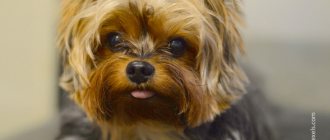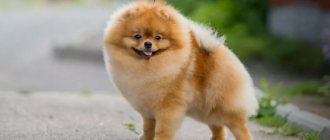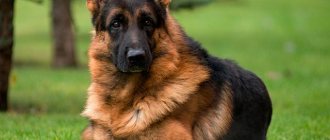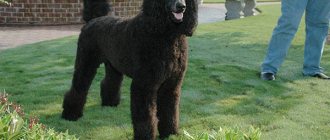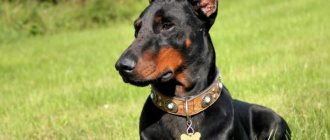Pugs are funny and cheerful companion dogs that have proven their devotion to humans for several centuries. The pug's calling is to love its owners, to be a true friend to both small children and elderly people. That is why the first thing you want to know when you adopt a dog of this breed is how long do pugs live? How many years will these funny pets be around? What should you do to prolong the joy of communicating with your dog? You will find the answer to all these questions in our material.
What affects life expectancy?
This breed is distinguished by good health and a strong physique, so the average age of its representatives is approximately 11-14 years. The lifespan of pugs largely depends on the conditions in which the dog lives.
The main factor is diet. Namely, from its correctness and rationality. Your pet's diet should not contain sweet, fatty or fried foods.
This is important because Pugs are prone to obesity. It significantly reduces life expectancy. The fact is that although such dogs are very cheerful, they can be very slow and store more than they spend.
Also, a significant factor is the anatomical structure of the muzzle. The eyeball may fall out due to the fact that the eye sockets are relatively shallow (compared to the large eye). A dog can receive such an injury during play or a fight, but it can cause complete loss of vision.
Another reason is genetic characteristics. It is possible that some diseases were passed on to the pet from its parents, so it would be a good idea to study the dog’s pedigree before purchasing.
How many years do pugs live at home?
Fortunately for pug lovers, their pets are long-lived. This is explained by the fact that representatives of the breed are small in size (30 cm is the average height at the withers, weight is from 4 kg to 10 kg). Their lifespan is from 12 to 15 years.
Boys
Despite the fact that male pugs are born stronger and larger, they live less than girls. The reason lies in character and behavior. Males are more stubborn, cocky and capricious. While walking, they easily get into fights and receive injuries that are detrimental to their health and often seriously threaten their lives. These statistics based on the characteristics of male dogs are true for most breeds, regardless of size and other characteristics.
Girls
By nature, pug girls are calmer and more flexible. They rarely take part in fights and are less injured. Their life expectancy depends on what genetic baggage they received, their diet and lifestyle. Under similar conditions, females live longer than males, reach old age, and become long-lived. Frequent pregnancies, difficult childbirths and long periods of feeding their offspring can undermine their health and shorten their lives.
How to find out the age of a pug?
There are several characteristics based on which you can roughly guess the age of a dog. It will tell us: the condition of the coat, muscles, eyes and teeth.
Wool
With age, pugs' fur becomes dull and loses its silkiness. In some cases, oiliness appears. After the first molt (about 4-6 months), the hair becomes shiny, gains a little stiffness, and the color appears brighter. But at the age of about 7 years, gray hair appears.
Muscles
Young individuals have very strong and elastic muscles, because they do not move more often. Over time, the dog either gets fatter or, conversely, becomes bony.
Eyes
Young pugs' eyes seem to glow. They are shiny and clear. Older dogs have dull eyes. The shine is most often lost.
Teeth
The teeth are a very important point. Looking at their condition, you can relatively accurately determine the age of the pet. In the first months of a dog's life, there is a period during which the body actively grows and develops.
- The puppy is born without teeth, but every month there are more and more teeth.
- On the 25th day, fangs appear, later incisors, milk and molars.
- The change from dairy to indigenous ones usually occurs at 3-5 months of life.
- By the age of one year, all teeth are fully formed and have a white color.
- By the age of two, the teeth already turn yellow and even tartar appears.
- By the age of 4, the teeth wear away and the yellowness is noticeable to the naked eye.
- At 10 years of age the final loss occurs.
Some characteristics of the animal make it very difficult to determine age.
Ways to extend life
To prolong the life of a pet, it is necessary to provide it with proper care. It is important to devote time to the dog’s psychological state. Pugs are very sociable and friendly, so owners should give their love and affection in return.
Take care of your nerves
When taking home a pug, you need to remember that dogs are peaceful and very sensitive. They cannot be scolded or beaten. A negative attitude is bad for your pet's nerves. The dog becomes intimidated.
It is important to show care, play and pet your pet
Avoid stress
Stressful situations can happen if a person does not pay attention to the dog or is away from home for a long time. When going on a long business trip, your pet should not be left alone. Pugs begin to worry and feel sad. Against this background, various pathologies can develop.
It is also worth protecting a small dog from communicating with large dogs, which can scare the pug.
Table of the age ratio of a pug and a human
| Pug age | Person's age |
| 5-6 weeks | 2 years 6 months |
| 12 weeks | 5 years |
| 6 months | 10 years |
| 9 months | 12 years 6 months |
| 1 year | 16 years |
| 2 years | 24 years |
| 3 years | 28 years |
| 4 years | 32 years |
| 5 years | 36 years |
| 6 years | 40 years |
| 7 years | 44 years old |
| 8 years | 48 years old |
| 9 years | 52 years old |
| 10 years | 56 years old |
| 11 years | 60 years |
| 12 years | 66 years old |
| 13 years | 72 years old |
| 14 years | 78 years old |
| 15 years | 84 years old |
| 16 years | 90 years old |
A short life is given by nature
Pugs that have crossed the age of 14 are considered to be long-lived. This means that everything went smoothly in their life. And if there were any diseases, they were not deadly. Statistics indicate that the oldest pug in the world was a dog named Martin, who lived in Russia. Because his age has exceeded 16 and a half years, the pug was awarded the Guinness Book of Records. So far he has beaten everyone in this competition.
Nature has decreed that the dog catches up with the age of its owner every year, and then surpasses it. Look carefully at the table corresponding to the number of years of a person and a pug (weight up to 9 kilograms):
If we convert Martin's age into human terms, it turns out that he died at 82 years old. It turns out that the dog was not that old, that is, by human standards, he was not long-lived at all.
Diseases and common causes of death in pugs
The life expectancy of these dogs very much depends on the presence of diseases, to which pugs are predisposed due to the characteristics of the breed. Due to their anatomical specificity, the following diseases are distinguished.
Poor circulation
The special structure of dogs' bodies often contributes to poor circulation. This can be seen especially clearly near the femoral head. This gradually leads to muscle atrophy and joint damage. If you are not careful, the pug can get necrosis (tissue death) of the limb, and with such a disease the dog is unlikely to live even to 7 years.
Heart diseases
A congenital disease in a pug is often a “heart defect,” which cannot be prevented, but if detected in time, you will be able to control everything.
Almost all pugs have a rather weak heart. Therefore, it is difficult for pets to tolerate sudden temperature changes and heat. Overly active representatives can even die from cardiac arrest, so during heavy exertion, be more careful to ensure that your pug does not experience shortness of breath. Also try to relieve your pet from stressful situations.
Infections
Various bacteria and fungi have a negative effect on dogs. Being outside, a pug can easily become infected. The wounds your pet receives must be treated immediately, otherwise they may fester. We must not forget that in winter the dog can catch a cold.
Eye diseases
Due to the special shape of the eyeball (bulging eyes lead to a small bony orbit), glaucoma, or chronic keratitis, often develops. The fact is that they literally don't have enough space in their skull.
When the cornea is damaged, pinpoint opacities are visible. This is keratitis, that is, inflammation of the cornea. It also manifests itself as cloudiness, redness, pain or ulcers.
Skin diseases
Bald spots, wet wounds and pimples often appear on the skin of pugs. All of these could be signs of an allergy. Sharp molting occurs due to stress, the appearance of parasites or poor genetics. But the rare presence of pimples in the folds of a dog's muzzle is normal.
Cancer
This disease is a real thief of a pet’s life expectancy. The most common forms are: oral cancer, testicular cancer and lymphoma. Castration is an excellent prevention of genital cancer.
Optimal living conditions for your pet
Pugs are indoor pets and are not suitable for keeping in a kennel or enclosure . Keeping it in an apartment has a beneficial effect on the dog’s health and can prolong its life.
Pros of keeping a pug in an apartment:
- relatively constant air temperature;
- low probability of running into a sharp object or getting into an altercation with another pet;
- more contact with household members. Pugs do not tolerate loneliness well and always follow in the footsteps of their owner;
- less risk of contracting infectious diseases;
- cleanliness and comfort.
The pug does not tolerate low and high temperatures well, so it is not suitable for keeping in a kennel or outdoors
A friend has a pug who is already 7 years old. The dog is quite active on walks and is always ready to play with my four-year-old daughter. But the constant snoring and intense salivation during sneezing are a bit of a turn off for this doggie. It also surprises me that a dog cannot keep its genitals and anus clean on its own. Due to her physique, she cannot reach to clean them with her tongue, as other pets do. Therefore, Katya (the owner of the pug) has to wash her several times a day.
How to increase the lifespan of a pug
To extend your pet's lifespan, you need to properly care for it.
Pugs, by their nature, have some predispositions to certain diseases that are very difficult to avoid. But if a dog receives proper care every day, it can live a long and happy life.
Obesity
Pugs, like most dogs, do not feel much when eating, so it is important to give your pet food only according to a certain diet.
Try to compose it correctly, because overweight pets live much less (5-6 years) than their more athletic relatives. Also, because of this, additional health problems may follow, namely: it complicates the breathing process and puts additional stress on an already weak heart. The diet should contain vitamins A, B, C and E.
Moderate physical activity
While still puppies, accustom your dogs to mandatory regular physical activity in different weather conditions. It is better to increase it gradually, increasing it every week. But don't overload.
Of course, in hot or bitterly cold weather we exclude physical exercise outside. If the pug does not exercise often, this will lead to severe shortness of breath and muscle atrophy.
Inspection
After each walk the animal is examined. Check your pet's eyes, because they are usually quite susceptible to injury, insect bites and dust.
It is also very important to ensure that the pug does not overheat. Don't forget about the vaccination schedule. It is important to pay attention to the slightest change that is uncharacteristic for the animal (lethargy, problems with appetite). Watch your skin carefully. There should be no wounds, bumps or seals on it. Go to the vet whenever possible.
Hygiene
Careful hygiene is the key to a healthy dog, and therefore a condition for a long-lived pug. During hot summer walks, treat the pug's especially deep folds well with an antiseptic. It is important to constantly clean the ears and occasionally the anal glands.
Proper nutrition
There are two opinions about what to feed your pet.
A diet based on natural products is very difficult to follow, since the pug must receive all the necessary vitamins.
If you choose this diet, then follow these recommendations:
- the dog always has water available;
- food at room temperature;
- food is not liquid;
- Most of the diet is meat;
- small amount of salt.
Dogs should not eat:
- pork:
- sugar;
- sausages;
- fried food;
- spices;
- fatty broth;
- bones;
- I'm eating from the owner's table.
It is easier to maintain food intake, since it already contains the substances the dog needs. This feeding option also saves you time.
However, we must remember that it is strictly prohibited:
- alternate food from different companies;
- pour boiling water over it;
- combine with natural feeding.
Briefly about the main thing
- The lifespan of pugs depends on their diet, genetics and anatomical structure.
- The age of a dog is determined by looking at the condition of its teeth, fur, muscles and eyes.
- Female pugs live longer than male pugs due to their calm nature.
- This breed is susceptible to heart disease, eye disease, circulatory problems, skin diseases, respiratory problems and various infections.
- To increase your life expectancy you need regular activity, hygiene, sensitivity, attention and proper nutrition.
Bad heredity
There are diseases that are inherited and can shorten a pet’s life:
- Encephalitis is an incurable disease that manifests itself in the form of convulsions and the release of foaming saliva, which indicates a seizure. Death can occur at any age. It is possible to verify the absence of the disease only with the help of a DNA test;
- dislocation of the kneecap , which in itself does not affect the life expectancy of the pug, but requires surgical treatment using anesthesia, which puts a strain on the heart;
- joint destruction caused by lack of blood circulation can shorten a dog's life by half;
- hip dysplasia , which requires treatment with medications (painkillers, anti-inflammatory) that weaken the heart.
IMPORTANT!
To avoid these inherited diseases, you should carefully select a dog from a breeder. Ask if his parents were sick and how long they lived.
Take care of your nerves
The positive emotions that daily communication with a person can give a dog are very important for health, and therefore longevity. Pugs are a sensitive breed and infinitely in love with their owner. Therefore, your affectionate touch to your pet and every encouraging exclamation give him vitality. Always remember this and do not skimp on praise and affection.
Make sure that family members and other people do not offend your friend, and, moreover, do not bring him physical suffering. Try to communicate with the dog calmly and gently, take care of his nervous system so that an emotional breakdown does not turn into a tragedy.
But, of course, there are other reasons that influence the number of years the dog will spend next to you. Objective factors that increase the life expectancy of a pug are:
- good care and maintenance;
- properly balanced diet appropriate for age and condition;
- disease prevention;
- competent actions of the owner in case of development of breed and other diseases;
- timely assistance in case of an accident.
Breed traits
Breed traits (on a 5-point scale)
| Pug | |||
| Activity | in the house | 2.7 | |
| on the street | 3.2 | ||
| Obedience | training | 3.1 | |
| strangers | 3.4 | ||
| Domination | in family | 1.6 | |
| over dogs | 2.2 | ||
| Defending your territory | from people | 1.6 | |
| from dogs | 2.1 | ||
| Sociability | in family | 4.4 | |
| with strangers | 4.2 | ||
| with dogs | 3.6 | ||
| Concentration | in family | 1.4 | |
| in front of strangers | 1.4 | ||
| with dogs | 1.5 | ||
| Aggressiveness | in family | 1.2 | |
| to strangers | 1.3 | ||
| to the dogs | 2 | ||
| to cats | 1.9 | ||
| Family behavior | calmness | 3.8 | |
| demand for affection | 4.4 | ||
| excitability | 4.2 | ||
| playfulness | 4.3 | ||
| excessive barking | 2.4 | ||
| behavioral breakdowns | 1.8 | ||
| Tolerance for children | up to 4 years | 4 | |
| over 4 years old | 4.3 | ||
| Institutional use | watchman | 3.5 | |
| bodyguard | 1.2 | ||
This breed is often compared to the following dog breeds: Pomeranian, Pembroke Welsh Corgi, Yorkshire Terrier, French Bulldog, Pekingese.
History of the breed
These small dogs have been living next to humans for more than 3,000 years. The first images and mentions of them in history date back to the 6th century BC. e. - at that time they were getting divorced in China and living in the palaces of the nobility. The Chinese saw hieroglyphs in the folds on the foreheads of these dogs, considering this an imperial sign. Therefore, they often lived better than ordinary people: they had their own rooms and servants. Ancient pictures show that they were carried on stretchers to prevent overwork.
Pug face
In China, these dogs were described as square, low, with a short muzzle, they were short-haired, unlike the long-haired ancestors of the Pekingese. Pugs were highly valued and expensive. They appeared in Europe in the 16th century and rich people also began to keep them. Many pictures of noble ladies holding such a pet on their laps have survived to this day. It was believed that they loved pug dogs because of their wrinkled face, which made them look like monkeys.
Gradually the breed spread to Europe. Pugs were first bred in Holland, then they were brought to Great Britain, France and other countries. But in the 18th century they became no longer so popular; they were started by merchants, merchants and even ordinary people. Therefore, pugs were in danger of degeneration. When, in the second half of the 19th century, Queen Victoria wanted to have this cute pet, she could not find a purebred puppy, so these dogs were again imported from China.
They began to be bred in Great Britain, and by the end of the 19th century the first mops club appeared. At the same time, a breed standard was created. Unlike Chinese dogs, European dogs have become short-legged, powerful, with a short nose, and larger in size.
These dogs came to Russia only at the beginning of the 20th century. But because of the revolution and two wars, no one dealt with them. Only in the 80s of the 20th century were the first pugs from the GDR brought to Moscow. After this, their breeding began. Over the past few years, the pug has been one of the most popular decorative breeds all over the world.
You can watch the video in more detail about the pug breed:
Symptoms
The main sign of a diseased heart is exercise intolerance: weakened heart muscle is not able to send blood (along with oxygen and nutrients) to the peripheral vessels.
If a pug doesn’t move much, it quickly gets tired under load, and the owner hears its rapid, heavy breathing. This is shortness of breath (a compensatory mechanism), whose appearance at rest promises bleak prospects for the dog.
Shortness of breath is usually accompanied by:
- changes in the color of the mucous membranes of the eyes and mouth (they become bluish-pale or bright red and swollen);
- tachycardia - in pugs the heart accelerates to 120-140 beats per minute or more;
- bradycardia (infrequently) – the “motor” beats less than 80 beats per minute;
- spontaneous periodic cough, as the heart presses on the main bronchi;
- an increasing need for fluid - this is how the body tries to replenish the weak pressure in the periphery.
When the disease enters the terminal (irreversible) stage, others may be added to the above symptoms, for example:
- swelling of the head and limbs (rare);
- hydrothorax - accumulation of fluid in the chest cavity;
- ascites, when the abdominal cavity fills with fluid, leading to a noticeable enlargement of the abdomen.
In each case, excess fluid compresses the pug's insides, interfering with their work and complicating the course of the disease.
Return to content
